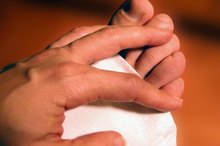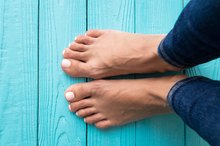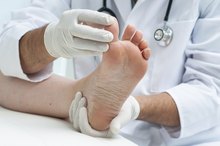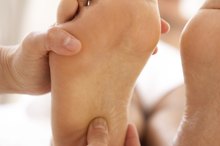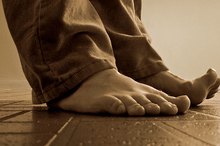Numbness in the Tip of the Big Toe
Most people get numb toes once in awhile, from wearing tight shoes or from prolonged sitting or standing. But this symptom can be worrisome when the toe stays numb.
If you are experiencing serious medical symptoms, seek emergency treatment immediately.
Persistent big toe numbness, which sometimes impacts only the tip of the big toe, is usually related to nerve damage or poor circulation. Since ongoing loss of feeling indicates an underlying cause, it's important to see your doctor, so you can understand the cause and have a plan to protect your feet.
Short-Term Causes
A common cause of temporary toe numbness is when your shoes directly compress the nerves in your feet or toes. In addition, spending too much time in a certain position — such as sitting or standing — can lead to numbness as nerves get pinched or blood flow is reduced.
A foot cast or brace that is too tight and exposure to cold temperatures can also lead to numb toes. This temporary numbness is managed by avoiding the trigger. Wear shoes that fit well, and get professionally fitted for shoes if needed. Avoid prolonged standing or sitting, and protect your feet in the cold by wearing weather-appropriate footwear.
- A common cause of temporary toe numbness is when your shoes directly compress the nerves in your feet or toes.
- A foot cast or brace that is too tight and exposure to cold temperatures can also lead to numb toes.
Peripheral Neuropathy
Numb Toes With Running Shoes
Learn More
Persistent toe numbness may be a consequence of peripheral neuropathy, or damage to the nerves in the extremities 2.
Over time, this numbness may spread to the entire toe, foot and leg. The damage from neuropathy is not reversible, and treatment is directed at managing pain, foot care and treating the underlying cause in order to prevent additional damage.
Other Nerve-Related Causes
Another cause of numbness is sciatica, which occurs when the sciatic nerve -- which runs from the spine down the leg -- gets pinched or damaged.
Other causes of nerve damage that can lead to toe numbness include vitamin B12 deficiency and brain conditions such as a stroke or multiple sclerosis. Nerve irritation or damage may also be more likely when foot deformities are present, such as bunions. Treatment is geared at controlling or removing the underlying cause, and managing neuropathy pain.
- Another cause of numbness is sciatica, which occurs when the sciatic nerve -- which runs from the spine down the leg -- gets pinched or damaged.
Impaired Circulation
A Blood Clot in the Big Toe
Learn More
Numbness in the big toe may also be related to peripheral artery disease (PAD), which is characterized by the narrowing of the arteries that supply blood to the extremities 1. PAD is caused by atherosclerosis, which leads to plaque accumulation on the arterial walls.
These narrowed arteries restrict blood flow to the legs and feet, and this results in abnormal sensations, including numbness in the big toe. Common PAD symptoms include pain or cramping which resolves upon rest. Treatment for PAD usually consists of a combination of medications and lifestyle changes.
- Numbness in the big toe may also be related to peripheral artery disease.
Warnings
If you have persistent numbness in your toes or feet, let your doctor know, since this symptom has an underlying cause which needs to be evaluated and effectively treated.
Also, visually inspect your feet every day for injuries, sores or infections, since you may not be able to feel pain or the sensation of temperature or discomfort in your numb area. See your doctor right away if you have neuropathy or PAD and have a sore, injury or infection on your feet.
Reviewed by Kay Peck, MPH RD
- If you have persistent numbness in your toes or feet, let your doctor know, since this symptom has an underlying cause which needs to be evaluated and effectively treated.
- See your doctor right away if you have neuropathy or PAD and have a sore, injury or infection on your feet.
Related Articles
References
- Merck Manual: Peripheral Artery Disease
- Merck Manual: Polyneuropathy
- BMJ: Diagnosis and Treatment of Sciatica
- National Institutes of Health: National Institute of Neurological Disorders and Stroke: Peripheral Neuropathy Fact Sheet
- Schreiber AK, Nones CF, Reis RC, Chichorro JG, Cunha JM. Diabetic neuropathic pain: Physiopathology and treatment. World J Diabetes. 2015;6(3):432-444. doi:10.4239/wjd.v6.i3.432
- Callaghan BC, Price RS, Feldman EL. Distal symmetric polyneuropathy: A review. JAMA. 2015;314(20):2172-2181. doi:10.1001/jama.2015.13611
- Frykberg RG, Zgonis T, Armstrong DG, et al. Diabetic foot disorders. A clinical practice guideline (2006 revision). J Foot Ankle Surg. 2006;45(5 Suppl):S1-S66. doi:10.1016/S1067-2516(07)60001-5
- American Heart Association. Peripheral Artery Disease and Diabetes. Updated January 31, 2016.
- Gupta N, Arora M, Sharma R, Arora KS. Peripheral and central nervous system involvement in recently diagnosed cases of hypothyroidism: An electrophysiological study. Ann Med Health Sci Res. 2016;6(5):261-266. doi:10.4103/amhsr.amhsr_39_16
- Hypothyroidism (Underactive). American Thyroid Association. Published 2017.
- U.S. Department of Health and Human Services, National Institutes of Health, National Heart Lung and Blood Institute. Your Guide to Anemia. 2012.
- Ekabe CJ, Kehbila J, Abanda MH, Kadia BM, Sama C-B, Monekosso GL. Vitamin B12 deficiency neuropathy; a rare diagnosis in young adults: A case report. BMC Res Notes. 2017;10(1):72. doi:10.1186/s13104-017-2393-3
- American College of Foot and Ankle Surgeons. Foot Pain? You May Have Diabetes. Updated October 22, 2008.
- American Diabetes Association. Peripheral Neuropathy.
Writer Bio
Lindsay Boyers has a Bachelor of Science in nutrition from Framingham State College and a certificate in holistic nutrition from the American College of Healthcare Sciences. She is also a licensed aesthetician with advanced training in skincare and makeup. She plans to continue on with her education, complete a master's degree program in nutrition and, ultimately, become a registered dietitian.

